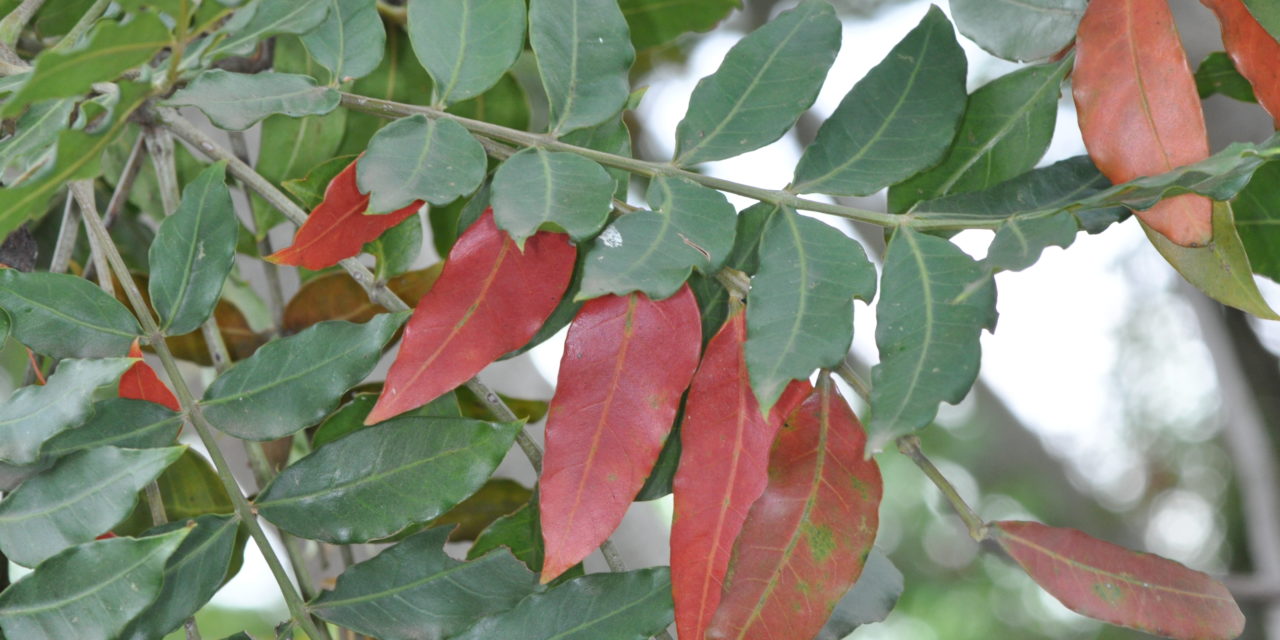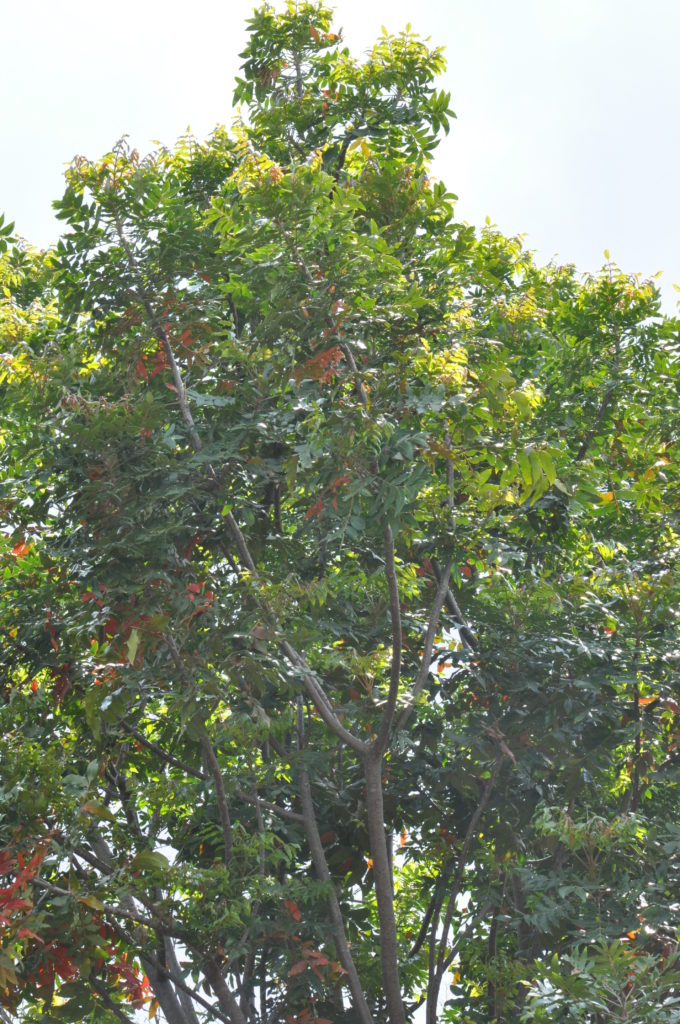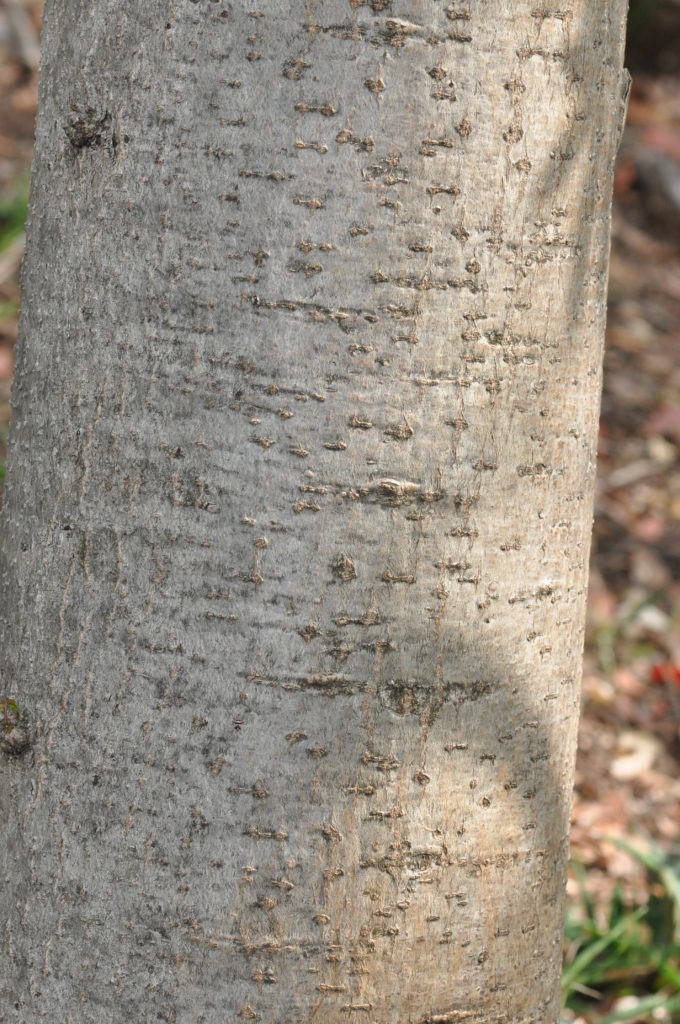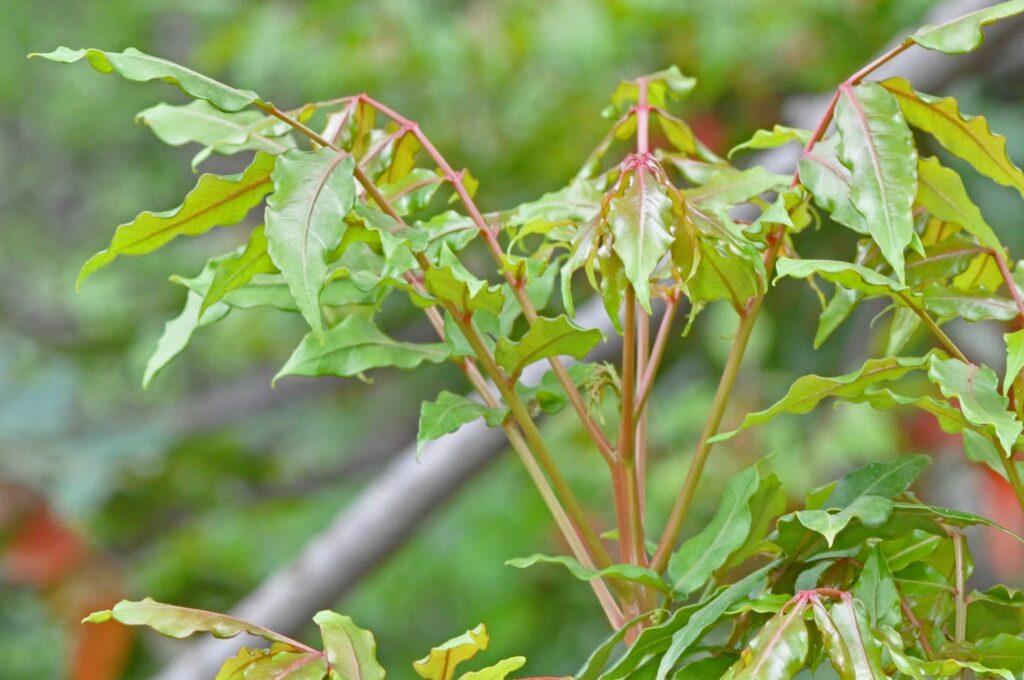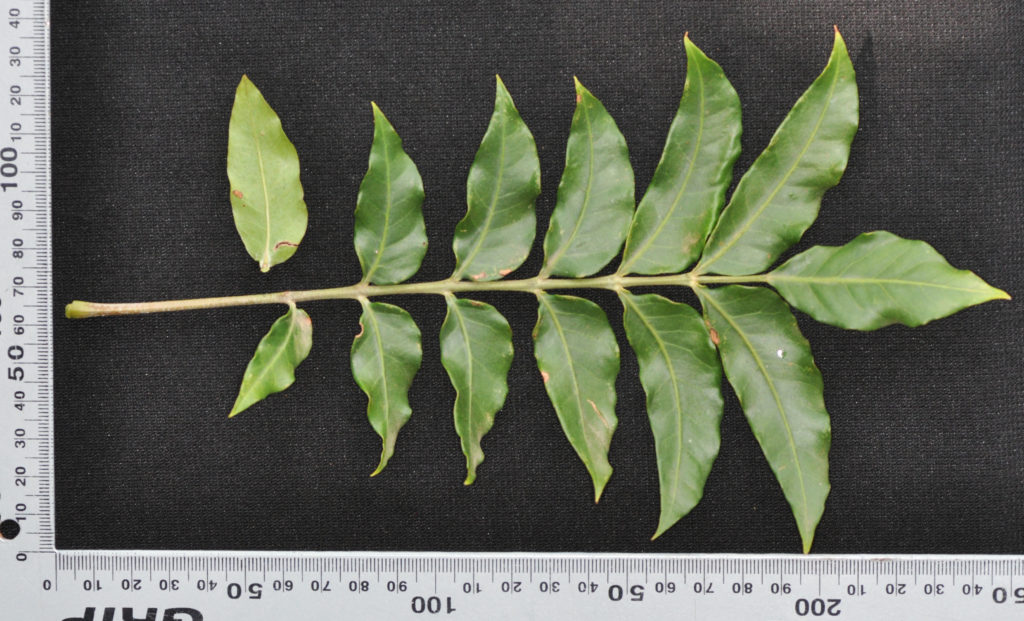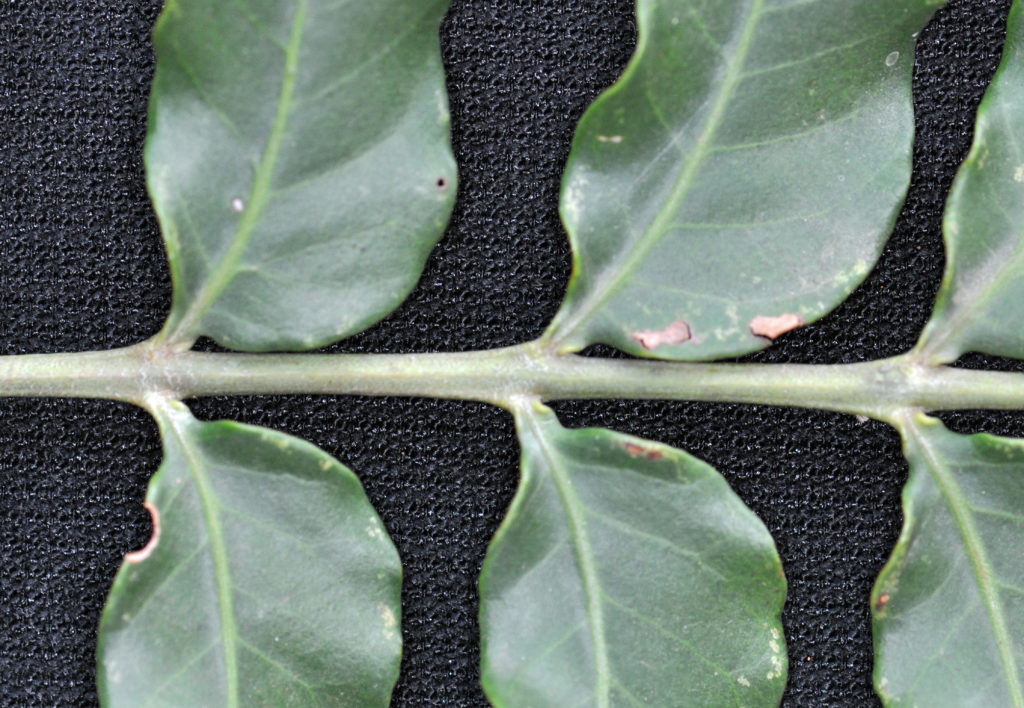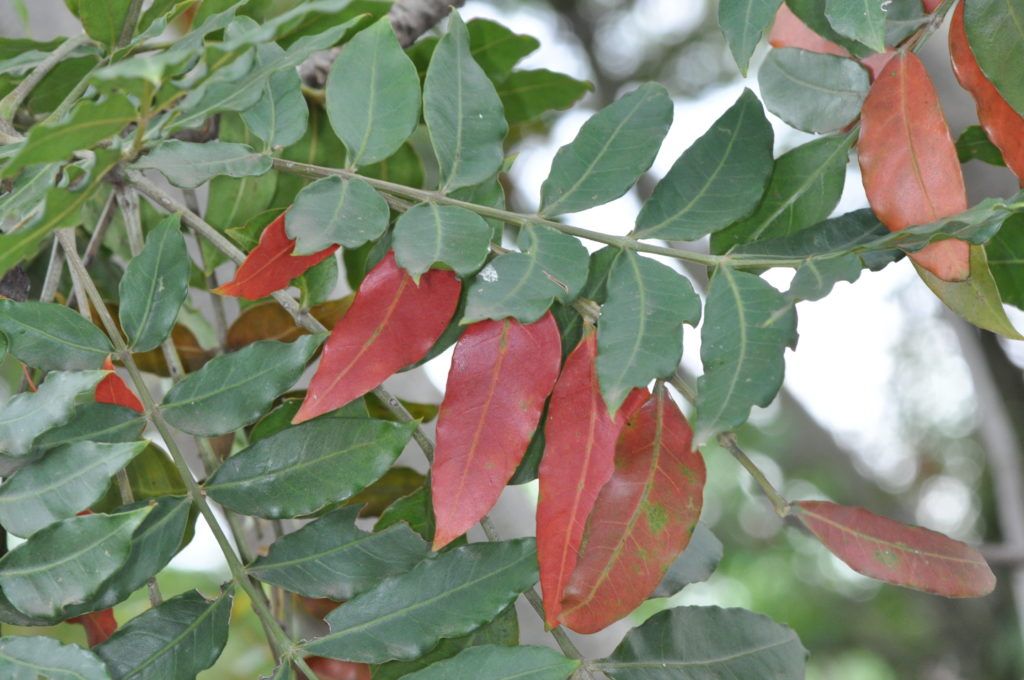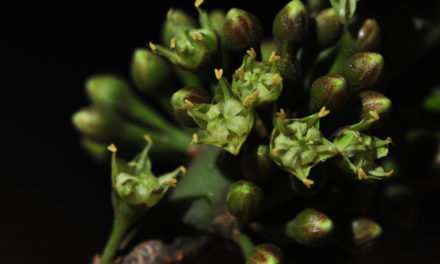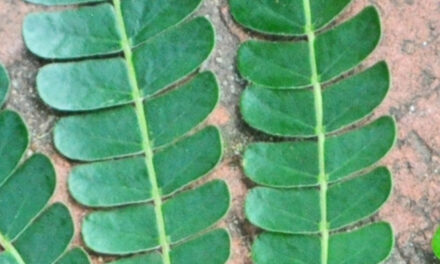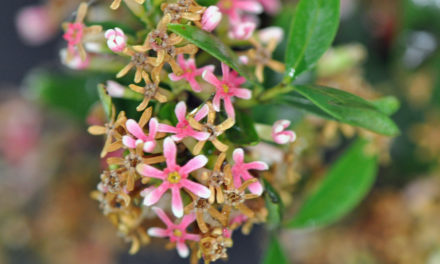General Info – summary
A medium sized dioecious Tree to 30m high. Lenticels present in horizontal groups. Imparipinnate hairless, smooth, leathery, 30cm long Leaves, lack stipules. Bright red leaflets may occur. Small whitish, 4-5 merous and regular Flowers occur in panicles. Male has 7-10 stamens. Females have staminodes and a single pistil. Plumb-like Fruit is a fleshy red drupe. Each produces one flattened oblong reniform seed.
Description
Harpephyllum caffrum
SA Tree No. 361.
Common names: (Afr) Essenhout, Gwenjabessie, Gwenja-bessie, Kafferpruim, Pruim, Suurbessie, Suurpruim, Wildepruim, Wilde-pruim, Zuure Pruim. (Eng) Kaffir Date, Kaffir Plum, Plum, Sour Plum, Wild Plum. (isiXhosa) Ichanti-lomlambo, Ingwenve, Isacoyi, Umgwenya, Umgwenye, Umgwenye-hangul, Umgwenyobomvu. (isiZulu) Umgwenya. (Northern Sotho) Mmedibibi, Mothêkêlê. (siSwati) Umgwenya, Umgwenye.
Family: Anacardiaceae: (Mango family), which has about 83 genera and 850+ species – including Cashew). Resin canals are present and woolly stellate hairs cover all young parts. Leaves lack stipules. They may be deciduous or evergreen and usually alternate. Leaves are simple, trifoliate or digitally compound and imparipinnate. Leaflets are usually opposite. Crushed leaves may smell of turpentine. Trees are monoecious or dioecious with occasional bisexual Flowers. Flowers are small, usually regular. The Calyx has 4-7 sepals and there are 4-7 Petals. The number of Stamens is the same as, or twice the number of petals and the Anthers are versatile. The superior Ovary has up to 4 locules, each with a single ovule. The 1-5 Styles are free or connate and separated at the base. Fruit is usually an indehiscent fleshy drupe with a single Seed. The southern Africa genera containing trees on this website include Harpephyllum, Lannea, Loxostylis, Ozoroa, Sclerocarya and Searsia.
Name derivation: Harpephyllum refers to the falcate (sickle shaped) leaflets. caffrum – from the Eastern Cape.
Conservation: National Status: L C. (Least Concern). Assessment: 2008 (V.L. Williams, D. Raimondo, N.R. Crouch, A.B. Cunningham, C.R. Scott-Shaw, M. Lötter & A.M. Ngwenya).
Tree
This tall Tree is usually up to 20m high; however, it may reach 35m or more in forests. The crown may be round and compact or spreading. The Stem (main axis of the plant, the leaf and flower bearing as distinguished from the root-bearing axis) is initially straight and smoothish (photo 351) and, in older trees, the bark becomes rough and dark grey-brown. Large Roots may develop on the forest floor. The Base may be buttressed – especially in the forest. The Branchlets have thickened endings and branches tend to curve upwards (photo 357). Broken parts exude sap. The Bark is initially brown or silver-white with raised Lenticels (usually raised corky elongated areas on the plant that allows the uncontrolled interchange of gases with the environment). These occur in horizontal running groups (photo 351).
- 357. 2016/11/08. Pretoria NBG. Photo: David Becking.
- 351. 2016/11/08. Pretoria NBG. Photo: David Becking.
Leaves
The alternately arranged Leaves are concentrated towards the ends of thickish branchlets. They closely resemble Ekebergia capensis in the family Meliaceae. In Harpephyllum caffrum the young leaves may be slightly pink (photo 356). Leaves may remain on the tree for up to 2 years and leaflets may turn bright red before they fall (photo 353). This is a distinctive characteristic. The trees are therefore evergreen. There are no red leaves in Ekebergia capensis whose leaves tend to droop, and this drooping is less obvious in Harpephyllum caffrum. In Ekebergia capensis no watery sap is released when leaves are damaged, no leaflets are sickle-shaped, and no old leaflets turn bright red before falling.
In Harpephyllum caffrum the only once compound leaf may be up to 30cm long and Stipules (basal appendages of the petiole) are absent. Collectively the leaves form a thick apical crown. Individual leaves are imparipinnate (pinnately compound leaf ending in a single leaflet – photo 359). The hairless leaves are smooth and leathery. The Rachis (main axis bearing leaflets) is slightly winged (photo 360). The Petiole (leaf stalk) is grooved on the upper side and is up to 10cm long. A picked leaf oozes watery sap from the base of the petiole. In Harpephyllum caffrum there are 4-8 pairs of opposite or nearly so leaflets. Most leaflets are dark shiny green above (photo 360), lighter and dull below (photo 359). Each leaflet has 6-10 pairs of lateral veins. Leaflet size may reach 10 x 2,5cm. In seedlings or in coppice growth (when stems are cut or burned it causes regrowth from the stump or roots) – leaves may be longer. The Apex is narrowly tapering. The single, symmetric, terminal and lanceolate leaflet has a much longer (up to 2cm) Petiolule (leaflet stalk). The remaining paired leaflets are asymmetric (photo 360) with very short or absent petiolules. These paired leaflets are sickle-shaped with the Midrib unequally placed (photo 359). The Margins may be wavy and are entire (with a continuous margin, not in any way indented – photo 359).
- 356 2016.11.08 Pretoria NBG. Photo: David Becking.
- 359. 2016/11/08. Pretoria NBG. Photo: David Becking.
- 360. 2016/11/08. Pretoria NBG. Photo: David Becking.
- 353. 2016/11/08. Pretoria NBG. Photo: David Becking.
Flowers
On this Dioecious (unisexual floral structures with functional male and female parts on separate plants) tree, the small, whitish to yellowish green Flowers occur towards the ends of branches in axillary Panicles (indeterminate, branched inflorescence with stalked flowers). Each flower has 4-5 Sepals in the Calyx and 4-5 Petals in the Corolla. The petals extend beyond the calyx lobes. Male Flowers have 7-10 Stamens and free filaments are present. The Anthers are 2-thecous (with 2 pollen sacs), each of which dehisce longitudinally. Here the Ovary is vestigial (imperfectly developed, non-functional relic from the past). The Female Flowers have a Disc (a more or less fleshy or elevated development of the receptacle) which is saucer-shaped with a scalloped rim. Here there are conspicuous Staminodes (sterile stamens) present. There is a single Pistil (a unit of the Gynoecium, the female element of the flower, composed of the Ovary, Style and Stigma) and the superior, single chambered Ovary has 1 pendulous ovule. Locules (here the cavity within the ovary) has a thick wall. There are 4 or 5 separate Styles, and the Stigmas are truncate (appearing as if cut of at the end). (Oct-Feb).
Fruit
The thinly fleshy and oblong Fruit (3 x 1,8cm) is produced in large numbers and tends to hang in bunches. Each mature oblong fruit is a bright red Drupe (a fleshy, 1-seeded indehiscent fruit with the seed enclosed in a stony endocarp; stone fruit – peach) that is up to 2,5cm long. Large numbers of fruit may be produced in hanging branches. Each drupe resembles a plumb, is up to 3 x 1,7cm and the ripe fruit becomes bright red. Fallen fruit often covers the ground below the trees. The drupe stone or endocarp is like a peach pip, and is characteristically pitted and encloses a single oblong Seed. (Mar-Aug).
Distribution & Ecology
These Trees are forest dwellers – especially in coastal and riverine forests and are common along the escarpment – up to an altitude of 1 400m. This tree is a southern African Endemic (restricted to a particular geographic location). It occurs from the Eastern Cape near Nelson Mandela Bay, KwaZulu-Natal, Mpumalanga, Northern Province and Limpopo. It also occurs in Eswatini (Swaziland), Zimbabwe and in southern Mozambique. Monkeys, baboons, bats and bushpigs consume the Fruit. Birds, including the Trumpeter Hornbill, Knysna turaco (Knysna Loerie), Mousebirds, Barbets and African Green Pigeons eat the flesh. The Cape Parrots (Poicephalus robustus) have beaks with the strength to penetrate the very hard stony fruit and consume the kernel (a softer, often edible part of a nut, seed, or fruit stone contained within its shell). Larvae of the common Hairtail butterfly (Anthene definite definita) and the Eggar moth (Lasiocampa kollikerii) feed on the Leaves at night. The carrot Fern Asplenium rutifolium and many epiphytic Orchids may occur on this tree. In low frost areas this is an attractive street tree.
Ethnobotany
The rather sour Fruit is edible. Sour pulp makes a good jelly preserve and a rose wine. The Bark is used in traditional medicine and for producing a mauve or pink colour dye. The plants do coppice (in this case when stems are cut or burned it causes regrowth from the stump or roots). The Wood is pale red, fairly dense and strong but not very durable. Uses include furniture, beams and fuel. Domestic animals feed on the leaves. This tree Grows easily from seed and truncheons (stem cutting from a selected plant – used to produce genetically identical new plants). Note: the separate male and female trees are both necessary for fruit development. In this respect, using truncheons is recommended. The plant roots easily from a cut stem placed in the ground. This plant does best in areas with little frost and develops into a good shade tree. Good, cultivated specimens can be seen in the grounds of the House of Assembly in Cape Town. These attractive trees have been planted in Port Elizabeth, King Williamstown and Grahamstown. To indicate when to plant sorghum, some farmers use the flowering of Dombeya rotundifolia and the ripened fruits of Harpephyllum caffrum as indicators.
References
Boon, R. 2010. Pooley’s Trees of eastern South Africa. Flora and Fauna Publications Trust, Durban.
Burrows, J.E., Burrows, S.M., Lotter, M.C. & Schmidt, E. 2018. Trees and Shrubs Mozambique. Publishing Print Matters (Pty) Ltd. Noordhoek, Cape Town.
Coates Palgrave, M. 2002. Keith Coates Palgrave Trees of Southern Africa, edn 3. Struik, Cape Town.
Ginn P.J. Mcilleron W.G. and Milstein P. le S, 1989. The Complete Book of Southern African Birds. Struik, Cape Town.
Lawrence, G. H. M, 1951. Taxonomy of Vascular Plants, The Macmillan Company, New York. Tenth Printing 1965.
Palmer, E. & Pitman, N. 1972. Trees of southern Africa, Balkema, Amsterdam, Cape Town.
Schmidt, S. Lotter, M. & McCleland, W. 2002. Trees and Shrubs of Mpumalanga and the Kruger National Park.
van Wyk, B. & van Wyk, P. 1997 Field guide to Trees of Southern Africa, Struik, Cape Town.
Williams, V.L., Raimondo, D., Crouch, N.R., Cunningham, A.B., Scott-Shaw, C.R., Lötter, M. & Ngwenya, A.M. 2008. Harpephyllum caffrum Bernh. ex Krauss. National Assessment: Red List of South African Plants version 2020.1. Accessed on 2023/07/21.
Woodhall, S. 2020. Field Guide to Butterflies of South Africa, edn 2. Donnelley, RR, China.
http://www.delmasmall.co.za/community/schools/dec/teachers_resources/plant_trees.pdf
http://www.plantzafrica.com/planthij/harpephylcaf.htm
http://www.birdinfo.co.za/botanical/fruit/27_wild_plum.htm
http://posa.sanbi.org/flora/browse.php?src=SP

